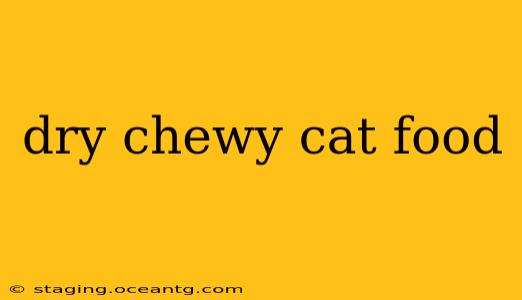Many cat owners encounter the frustrating issue of dry, chewy cat food. While some cats happily munch on kibble regardless of texture, others might turn up their noses or even struggle to eat food that's too hard or tough. This comprehensive guide explores the reasons behind dry, chewy cat food, how to identify the problem, and solutions to ensure your feline friend enjoys their meals.
Why is My Cat's Dry Food Chewy?
Several factors contribute to dry cat food becoming chewy. Let's examine the most common causes:
- Age and Dental Health: As cats age, their teeth can wear down or develop dental issues, making it difficult to crunch hard kibble. This is a major reason why older cats might find their food chewy or even impossible to eat.
- Ingredient Quality and Storage: Lower-quality ingredients or improper storage can lead to changes in the kibble's texture. Exposure to moisture or extreme temperatures can cause the food to become harder or more difficult to chew.
- Brand and Formulation: Different cat food brands and formulations have varying textures. Some kibble is inherently harder than others, even when fresh. Reading reviews and paying attention to texture descriptions can help you choose appropriately.
- Kibble Size and Shape: Smaller kibble tends to be easier to chew than larger pieces. Unusual shapes can also make it more challenging for cats to properly grasp and bite the food.
Is Chewy Cat Food Harmful?
Generally, chewy cat food isn't inherently harmful, but it can lead to several issues:
- Reduced Food Intake: Cats might refuse to eat chewy food, leading to malnutrition and weight loss.
- Dental Problems: Straining to chew hard food can exacerbate existing dental problems or even cause new ones.
- Jaw Pain: Persistent chewing of hard food can cause jaw pain and discomfort.
- Choking Hazard: Although less common, excessively hard kibble can pose a choking hazard, especially for smaller cats or kittens.
How Can I Soften My Cat's Dry Food?
Several methods can help soften dry, chewy cat food:
- Adding Water or Broth: The simplest solution is to add a small amount of warm water or low-sodium broth to the kibble. Allow it to sit for a few minutes to soften.
- Using a Food Processor: For significantly hard kibble, you can briefly pulse it in a food processor to reduce the size and make it easier to chew. Avoid over-processing, as this can create a powder-like consistency.
- Switching to a Different Brand: If the texture problem persists, try switching to a different brand known for producing softer kibble. Look for descriptions like "soft bites" or "easy-to-chew" on the packaging.
- Transitioning Gradually: If changing brands, do it gradually to avoid upsetting your cat's digestive system. Mix the new food with the old food over a week or so.
- Consult Your Veterinarian: If your cat is experiencing persistent difficulty eating due to dental issues or other health problems, consult your veterinarian for appropriate treatment and advice on dietary changes.
What if My Cat Refuses to Eat Softened Food?
If your cat still refuses to eat even after softening the kibble, there might be underlying issues requiring veterinary attention. Possible reasons include:
- Dental Disease: Painful teeth or gums can make eating difficult, regardless of food texture.
- Underlying Medical Conditions: Certain illnesses can affect appetite and food intake.
- Food Aversions: Your cat might have developed an aversion to the specific brand or type of food.
- Picky Eating Habits: Some cats are simply picky eaters and require more coaxing to eat.
What type of dry cat food is best for senior cats with dental issues?
For senior cats with dental problems, look for senior-specific cat food formulas designed with softer kibble or pate-style options. These formulas often include added nutrients beneficial for older cats and are formulated to be gentler on aging teeth and gums.
How can I store cat food to prevent it from becoming hard?
Proper storage is crucial to maintain the texture and quality of cat food. Store kibble in an airtight container in a cool, dry place, away from direct sunlight and moisture. Avoid storing it in areas with fluctuating temperatures, as this can affect the food's texture.
By understanding the reasons behind dry, chewy cat food and implementing the suggested solutions, you can ensure your feline companion enjoys nutritious and palatable meals, promoting their overall health and happiness. Remember, always consult your veterinarian if you have concerns about your cat's eating habits or dental health.
